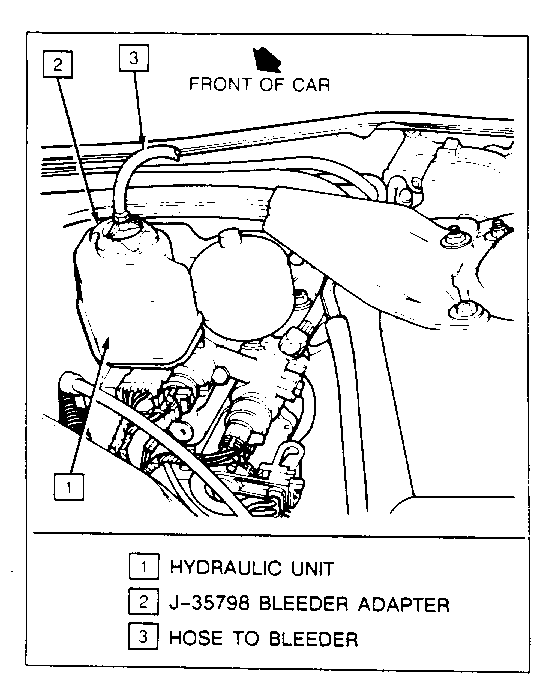BRAKE/ANTI-LOCK WARNING LAMPS NO POWER ASSIST OR PUMP OPER.

MODELS AFFECTED: 1988 DE VILLES AND FLEETWOODS WITH ANTI-LOCK BRAKE SYSTEM (OPTION JM4)
1988 ELDORADOS AND SEVILLES WITH ANTI-LOCK BRAKE SYSTEM (OPTION JL9)
Effective in the 1988 model year, certain production changes were made to the pump/motor assembly used on Cadillac models equipped with the optional Teves Anti-Lock Brake System. The 1988 pump/motor assembly utilizes a cast iron body while past model assemblies are made of cast aluminum. Although some early 1988 vehicles were produced with aluminum pump/motor assemblies, all GMSPO service assemblies for the 1988 model use cast iron construction.
After installing a service pump/motor assembly on a 1988 vehicle, the pump may run continuously without building pressure in the ABS accumulator when the ignition key is tumed on for the first time. If this condition occurs, both the red "BRAKE warning lamp and the amber "ANTI-LOCK" warning lamp will be illuminated and the system will demonstrate a lack of power brake assist.
If this condition is encountered, use the following procedure to assist in pump priming. It should be noted this procedure applies only to new, cast iron body 1988 model service pump/motor assemblies. Once the pump has primed and has developed pressure, this condition will not occur. Refer to the appropriate Service Information Manual, Section 5El, for diagnosis of other conditions.
To assist in priming a new 1988 replacement ABS pump/motor assembly:
1. Be sure that the new pump/motor assembly is properly installed as described in Service Information Manual Section 5E.
2. Turn the ignition switch to the RUN position. Pump motor should start and run for approximately 30 seconds before tuming off again. If the pump does not turn off within 30 seconds, allow it to run for an additional 30 seconds before proceeding to step 3. In some cases, the new 1988 pumps will self-prime if they are allowed to run for an additional length of time.
CAUTION:
Do not allow the pump to run continuously for more than 60 seconds, as the pump may overheat.
3. If the pump has not stopped after 60 seconds, tum ignition OFF and remove reservoir cap. Install pressure bleeder adapter, J-35798, as shown in Figure 1.
4. Connect a standard diaphragm-type pressure bleeder to bleeder adapter as shown in Figure 1. Only DOT 3 brake fluid should be used in the pressure bleeder. Charge pressure bleeder to 20-30 psi.
5. Turn pressure bleeder on, allowing pressurized brake fluid from the bleeder to fill and pressurize reservoir. At the same time, tum ignition switch to RUN position.
6. The pump will start when ignition is turned to RUN and should stop within 60 seconds. When pump stops, turn ignition to OFF and remove pressure bleeder and adapter.
7. Using a clean syringe or equivalent method, remove excess fluid from the reservoir to bring fluid level to the full mark. Depressurize accumulator by pumping the brake pedal a minimum of 25 times. Adjust fluid to the full mark on the reservoir level using only DOT 3 2pfluid.
CALTTION: Do not remove brake fluid from the reservoir using a syringe or other instrument which is contaminated with water, petroleum based fluids, or any other foreign material. Contamination of the brake fluid may result in impaired system operation, property damage or personal injury.
8. Install reservoir cap and verify system operation. With the accumulator fully depressurized, the pump should turn on for approximately 30 seconds while the accumulator is pressurized and then turn off.

General Motors bulletins are intended for use by professional technicians, not a "do-it-yourselfer". They are written to inform those technicians of conditions that may occur on some vehicles, or to provide information that could assist in the proper service of a vehicle. Properly trained technicians have the equipment, tools, safety instructions and know-how to do a job properly and safely. If a condition is described, do not assume that the bulletin applies to your vehicle, or that your vehicle will have that condition. See a General Motors dealer servicing your brand of General Motors vehicle for information on whether your vehicle may benefit from the information.
